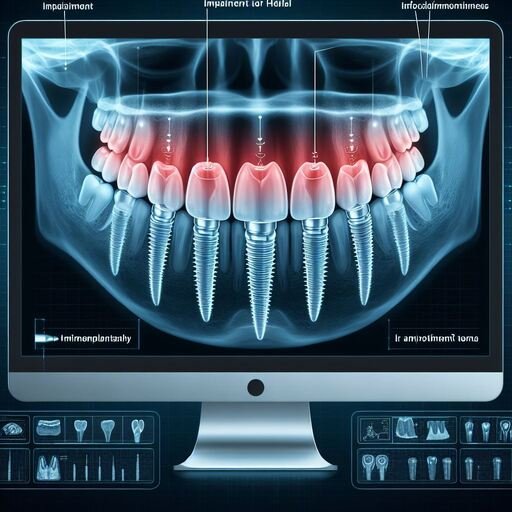Dental implants have revolutionized the way we approach a missing tooth or two, offering a durable and aesthetically pleasing solution for many. With a high success rate, they’ve become a preferred choice for patients and dentists. However, like any medical procedure, there’s a small possibility of complications. One such complication is dental implant rejection, a condition that, while rare, requires prompt attention to prevent further oral health issues. Understanding the signs of dental implant rejection is crucial for patients, as early detection can significantly enhance the chances of resolving the problem successfully. This article aims to guide you through the early and late signs of dental implant rejection, helping you recognize when it’s time to seek professional advice and ensure the longevity of your dental implant.

Understanding Dental Implants and Reasons for Rejection
Dental implants are a groundbreaking solution for replacing missing or damaged teeth, closely mimicking natural teeth’ look, feel, and function. Comprising a titanium post surgically inserted into the jawbone, an abutment, and a custom-made crown, dental implants offer a stable and permanent foundation for artificial teeth. Unlike dentures or bridges, implants integrate with the bone, a process known as osseointegration, providing unparalleled support and preventing bone loss.
The procedure of receiving a new dental implant typically involves several stages, including initial consultation, insertion of the implant post, healing period for osseointegration, and finally, the attachment of the abutment and dental crown. The success of a dental implant operation is largely contingent on this integration process, where the implant becomes securely anchored in the jawbone.
Given their design and the materials used, dental implants boast a high success rate, often exceeding 95%. This success is attributable to the biocompatible nature of titanium, which allows the bone to grow around the implant, securing it in place. However, despite this high success rate, there are instances where an implant may not integrate as expected, leading to what is commonly referred to as implant rejection or failure. Recognizing the early signs of this process is essential for addressing any issues promptly and ensuring the health and functionality of the implant and surrounding tissues.
What Causes Dental Implant Rejection?
Understanding the causes of dental implant rejection is crucial for prevention and early intervention. It’s important to note the distinction between rejection and failure.
Rejection can occur due to the body’s immune response, treating the implant as a foreign object. At the same time, failure typically results from external factors affecting the implant’s ability to integrate with the bone. Here are the common reasons for dental implant rejection:
- Infection (Peri-implantitis): An infection around the implant site, often due to poor oral hygiene or residual bacteria during surgery, can prevent the implant from properly integrating with the jawbone.
- Insufficient Bone Density: Successful osseointegration requires a certain amount of healthy bone. If the bone density is inadequate, the implant may not have sufficient support, leading to rejection.
- Allergic Reaction: Although rare, some individuals may have sensitivities or allergic reactions to the materials used in implants, such as titanium alloys, which can trigger an immune response.
- Smoking and Lifestyle Factors: Smoking can impede healing and interfere with the osseointegration process. Other lifestyle factors, such as poor oral hygiene and certain chronic illnesses, can also increase the risk of implant rejection.
- Overloading: Placing excessive pressure (directly or indirectly) on the implant before it fully integrates with the bone, either from premature placement of the prosthetic component or from habits like grinding teeth, can lead to failure.
Recognizing these potential causes and being on time are the first steps in mitigating the risk of dental implant rejection. Patients considering dental implants should discuss any concerns and medical history with their dentist to assess their risk and plan accordingly. Proper planning and care can significantly reduce the likelihood of implant rejection, leading to a successful and lasting tooth replacement.
Early Signs of Dental Implant Rejection
Identifying the early signs of dental implant rejection is key to addressing any problems promptly and effectively. While dental implants have a high success rate, being vigilant about potential signs of rejection can help individuals ensure their implants’ longevity and health. Here are some early indicators that may suggest your body is not accepting the dental implant as expected:
Pain and Discomfort
- Normal vs. Abnormal Pain: It’s common to experience pain and discomfort after the implant surgery. However, if the pain persists beyond the expected healing period or intensifies instead of gradually diminishing, it might indicate an issue with the implant.
Swelling and Redness
- Extended Swelling: Similar to pain, some swelling and redness around the implant site are normal immediately following the procedure. The concern arises when this swelling doesn’t subside as anticipated or worsens, possibly pointing to infection or inflammation related to rejection.
Gum Recession
- Receding Gums Around the Implant: If the gums start to pull away from the implant, exposing more of it than is typical, this can be a sign of poor integration or the body’s negative response to the implant.
Difficulty Chewing or Biting
- Uncomfortable or Painful Biting: An implant should function like a natural tooth. If you experience discomfort, pain, or an inability to bite down properly without discomfort, the implant may not integrate correctly with the jawbone.
Recognizing these signs early on is crucial. They don’t always mean the implant fails, but they warrant a consultation with your dental professional. Timely intervention can often correct or mitigate these issues, preserving the implant and maintaining oral health. If you notice any of these symptoms, it’s advisable to contact your dentist as soon as possible for an assessment and appropriate treatment.
Late Signs of Dental Implant Rejection
While early detection of potential issues can lead to more successful interventions, some signs of dental implant rejection may only appear later. These late signs often indicate more serious complications that require immediate attention and assessment from a dental professional. Understanding these indicators can help seek timely treatment, potentially saving the implant and preventing further oral health issues.
Loose or Shifting Implant
- Movement in the Implant: One of the clearest signs of implant failure is when the implant itself becomes loose or starts to shift. This movement can indicate that osseointegration has not occurred or that the bone supporting the implant is receding.
Visible Bone Loss
- X-Ray Evidence: Bone loss around the implant, which may not be immediately visible or felt, can often be detected through dental X-rays. Regular check-ups can help identify this issue, which suggests the implant is not properly integrated and is being rejected by the body.
Severe Infection
- Peri-implantitis: This condition is characterized by significant gum inflammation, including the bone around the implant. It can lead to bone loss and is a major cause of implant failure if not treated promptly. Signs include severe pain, pus, and bleeding from the implant site.
Gum Recession and Exposure of the Implant
- Increased Exposure: If more of the metal part of the implant becomes visible over time, it could be due to gum recession caused by infection or improper implant placement. This affects the aesthetic appearance and can lead to implant instability.
Persistent Discomfort and Inflammation
- Chronic Symptoms: Ongoing discomfort, swelling, and inflammation around the implant site, long after the expected healing period, can indicate that the body is rejecting the implant.
Why You Should Get It Checked
While concerning, late signs of dental implant rejection do not always mean the loss of the implant. Immediate and appropriate dental care can save the implant through treatments such as infection management, surgical intervention for bone grafts, or adjustments to the implant. The key is not to delay seeking professional advice at the first sign of trouble. Ignoring these symptoms can definitely lead to more severe complications, including the loss of the implant and further damage to your oral health. Regular dental check-ups and promptly addressing any discomfort or changes around the implant site are critical steps in ensuring the long-term success of your dental implant.
Preventing Dental Implant Rejection
While some factors leading to dental implant rejection are beyond individual control, you can take several proactive measures to minimize the risk and ensure the long-term success of your implant. Here’s how to create a favorable environment for your dental implant and reduce the chances of rejection:
Maintain Optimal Oral Hygiene
- Routine Cleaning: Brushing twice a day. Incorporating a daily flossing habit and using an antimicrobial mouthwash can help prevent infection around the implant site. Proper oral hygiene keeps harmful bacteria at bay, supporting healthy implant integration.
- Regular Dental Check-ups: We all dislike that annual dental visit, but a trip to your dentist for regular cleanings and check-ups allows for early detection of any potential sign of rejection. Your dentist can also provide specific care instructions tailored to your implant needs.
Ensure Adequate Bone Density
- Pre-implant Evaluation: Before the implant procedure, your dentist will assess the density and quality of your jawbone. They may recommend bone grafting to strengthen the area and provide a solid foundation for the implant if necessary.
- Avoid Pressure on the Implant: Until your dentist confirms successful osseointegration, it’s important to avoid putting excessive pressure on the implant area. Follow your dentist’s advice regarding diet and oral habits to prevent undue stress on the implant.
Avoid Risk Factors
- Quit Smoking: Smoking significantly impairs healing and can decrease the success rate of dental implants by affecting blood flow and bone health. Quitting smoking before and after the implant procedure can dramatically improve outcomes.
- Control Chronic Conditions: Conditions like diabetes, if not well-managed, can hinder healing and increase the risk of implant failure. Work with your healthcare provider to control any systemic health issues.
Choose a Qualified Dental Professional
- Experience Matters: Selecting a dentist or oral surgeon with extensive experience and a track record of successful implant procedures can reduce the risk of complications. They can expertly navigate any challenges, ensuring the best possible outcome for your implant.
Why Proactive Measures Matter
Taking proactive steps doesn’t just minimize the risk of implant rejection; it also promotes overall oral health and ensures the longevity of your dental implant. By maintaining good oral hygiene, avoiding risk factors, and following your dentist’s recommendations, you’re investing in the success of your dental implant. Remember, a successful dental implant not only restores function and aesthetics but also prevents bone loss and supports the health of surrounding teeth, making it a valuable investment in your oral and general well-being.
What to Do If You Notice Signs of Rejection
If you start to notice signs that may indicate dental implant rejection, it’s crucial to act promptly to address these issues. Early intervention can mitigate problems and even save the implant. Here’s what you should do:
Don’t Delay Seeking Professional Help
- Contact Your Dentist Immediately: At the first sign of discomfort, pain beyond the normal healing period, or any unusual symptoms around the implant site, contact your dental professional. They can assess the situation and determine the best course of action.
Prepare for Your Appointment
- Note Your Symptoms: Make a detailed list of your symptoms, including when they started, their intensity, and any triggers that worsen them. This information will help your dentist diagnose the issue more accurately.
- Discuss Your Concerns and History: Be ready to discuss any recent changes in your health, medication, or lifestyle that could affect your implant’s success.
Possible Treatments
Depending on the cause and severity of the issue, treatments can vary:
- Antibiotics: If an infection is present, your dentist may prescribe antibiotics to clear it up.
- Adjustment or Replacement: Sometimes, the implant or the crown may need adjustment. In some cases, removing and replacing the implant may be necessary.
- Bone Grafting: If bone loss around the implant is a concern, bone grafting might be recommended to provide better support.
- Improved Oral Hygiene Practices: Your dentist may suggest changes to your oral care routine or products to support implant health better.
Aftercare and Monitoring
Following your dentist’s treatment plan is essential for the recovery and longevity of your dental implant:
- Follow-Up Appointments: Keep all scheduled follow-up appointments to monitor the implant’s integration and address any emerging concerns promptly.
- Oral Hygiene: Maintain meticulous oral hygiene to support healing and prevent future issues.
- Lifestyle Adjustments: Make any recommended lifestyle adjustments, such as quitting smoking or controlling systemic health conditions, to improve outcomes.
Why Immediate Action is Important
Addressing signs of dental implant rejection early can significantly increase the chances of preserving the implant and maintaining oral health. Ignoring symptoms or delaying treatments can lead to more severe complications, including loss of the implant, further bone loss, and impact on adjacent teeth. By staying vigilant and proactive, you can ensure the best possible outcome for your dental implant and overall well-being.
FAQs About Dental Implant Rejection
Q: How common is dental implant rejection?
A: Dental implant rejection is relatively rare, with a high success rate overall. Most studies show success rates above 95% for dental implants, depending on various factors, including patient health, the skill of the dental professional, and post-operative care.
Q: Can dental implant rejection occur years after surgery?
A: While less common, dental implant rejection or failure can occur years after the initial placement. This late-stage failure is often due to peri-implantitis, a condition characterized by inflammation and bone loss around the implant.
Q: Are there any specific signs I should watch for in the years following my implant surgery?
A: Long-term vigilance is key. Signs such as persistent discomfort, swelling, gum recession, or any mobility in the implant should prompt a visit to your dentist. Regular check-ups can also help catch any issues early.
Q: Is dental implant rejection the same as an allergy to the implant material?
A: Not exactly. Rejection often refers to the failure of the implant to integrate with the bone, which can be due to various factors, including infection or insufficient bone density. An allergy to the implant material, such as a metal allergy to titanium, is much rarer and involves an immune response.
Q: Can dental implant rejection be prevented?
A: While not all cases of dental implant rejection can be prevented, risk factors can be minimized through proper planning and care. This includes choosing an experienced dental professional, adhering to good oral hygiene, avoiding smoking, and managing health conditions that could affect healing.
Conclusion: Making Informed Decisions on Dental Implant Care
Recognizing the signs of dental implant rejection and understanding the importance of early intervention are crucial steps in ensuring the longevity and success of your dental implant. Whether you’re considering an implant or already have one, being informed about potential issues and knowing how to respond can significantly affect the outcome.
While dental implants have a high success rate and offer a durable, aesthetically pleasing solution for missing teeth, they require a commitment to proper care and maintenance. By staying vigilant for signs of rejection, maintaining excellent oral hygiene, and keeping regular appointments with your dental professional, you can enjoy the benefits of your dental implant for many years.
Remember, don’t hesitate to contact your dentist if you notice any worrying symptoms or have questions about your dental implant. Making informed decisions about your oral health is key to a successful dental implant experience and overall well-being.



